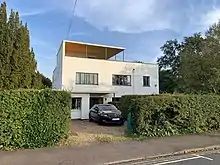Dora Cosens
Doris Morley Cosens (27 April 1894 – 5 October 1945; née Fletcher),[1] often referred to as Dora Cosens, was a British architect, particularly known for her Modernist house, 9 Wilberforce Road in Cambridge.[2] Along with Mary Crowley and Elisabeth Scott, she was among the earliest women architects to work in Britain during the modern era.[3]
Biography

She was born Doris Morley Fletcher in 1894 in Marylebone, London,[1] to Arthur Morley Fletcher.[4] She studied architecture at the School of Architecture of the University of Cambridge, probably under George Checkley.[1][2] In 1916, she married the engineer, Charles Richard (Dick) Garrod Cosens (1893–1956). At that date, he was in the Royal Engineers; after the First World War, he studied at King's College, Cambridge, and later became a lecturer in engineering at the University of Cambridge.[1]
During her married life, Cosens lived in Cambridge, latterly at 13 Millington Road.[1][2] She was in practice as an architect in the town and additionally gave her profession as an art critic.[1] Her reviews of books and exhibitions were published in the Architects' Journal;[1][2] the architectural scholar Alan Powers comments that these reveal her to have been "well informed and critical about contemporary developments".[2] Albert Hill describes her as an "energetic advocate of the Modern style".[5] Her career as an architect was limited by two world wars, the demands of married life and her early death.[3]
She died unexpectedly in Cambridge on 5 October 1945, aged 52.[1][4] Her funeral was held at Cambridge Crematorium.[4]
Works
Cosens designed Orchard Lawn, 23 Kings Road (1930). This has a traditional design, being an updated version of a Cambridgeshire cottage with a mansard roof; it includes an early example of a built-in garage and is designated a building of local interest.[6]
Her best-known work is 9 Wilberforce Road (1936–37),[2][7][8] built for the zoologist William Homan Thorpe.[9] One of twelve Modernist-style houses built in Cambridge before the Second World War,[10] it is listed at grade II.[11] The house is constructed in rendered or whitewashed brick on an atypical, almost-square plan, with two storeys. The flat concrete roof was designed for use as a roof terrace and features a prominent canopy. The main bedroom has a symmetrically placed balcony overlooking the garden,[2][11] and the arrangement of windows creates interest by changing with the viewpoint.[2] An important factor in the plan for the interior was to house Thorpe's piano.[9] Unusually, the dining room and sitting room are placed at right angles. Powers describes it as an "assured design", noting the influence of Checkley's earlier houses on Conduit Head Road.[2] The architectural historians Simon Bradley and Nikolaus Pevsner call it "rather heavily done".[7] The estate agent Albert Hill includes it in a 2006 list of the ten best modern houses in Britain, describing it as having a "rigidly linear box-like appearance".[5] The house was covered in the Architects' Journal in 1939.[2]
Cosens at least drew up plans for alterations and extension to 13 Millington Road in 1936, for King's College.[12] She was responsible for a small extension in 1944 to Willow House, a grade-II*-listed Modernist house on Conduit Head Road by Checkley (1932).[7][13][14]
References
- Cosens, Doris Morley 1894 – 1945. Biographical Dictionary of British and Irish Architects 1800–1950, AHRnet (accessed 21 October 2022)
- Powers, pp. 25, 94–95
- Claire Jamieson (27 November 2017). Women Who Build. Frieze (accessed 23 October 2022)
- Deaths. The Times (50266), p. 1 (6 October 1945)
- Albert Hill (1 April 2006). Designs for living. The Independent Magazine, pp. 83–85
- Cambridge City Council, p. 43
- Bradley, Pevsner, pp. 341–42
- Cambridge City Council, p. 30
- R. A. Hinde (1987). William Homan Thorpe. 1 April 1902–7 April 1986. Biographical Memoirs of Fellows of the Royal Society 33: 620–639 JSTOR 769965
- Jeremy Gould (1996). Gazetteer of Modern Houses in the United Kingdom and the Republic of Ireland. Twentieth Century Architecture (2): 112–128 JSTOR 41859593
- 9, Wilberforce Road, National Heritage List for England, Historic England (accessed 23 October 2022)
- Jude Brimmer, Michael Stansfield (2005). King's College Estates Records, King's College, Cambridge, p. 118 (downloaded 24 October 2022)
- Powers, p. 72–73, 94
- Willow House, National Heritage List for England, Historic England (accessed 23 October 2022)
Sources
- Simon Bradley, Nikolaus Pevsner. Cambridgeshire (The Buildings of England series) (Yale University Press; 2014) ISBN 978-0-300-20596-1
- Cambridge City Council (May 2011). West Cambridge Conservation Area Appraisal (accessed 24 October 2022)
- Alan Powers. Modern: The Modern Movement in Britain (Merrell; 2005) ISBN 9781858942551
External links
Further reading
- Architects' Journal 89: 448–49 (16 March 1939)
- C. R. G. Cosens obituary. King's College Annual Report 1954, p. 17